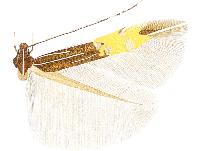Hypodrasia is a genus of moth in the family Gelechiidae. It contains the species Hypodrasia acycla, which is found in the Philippines (Luzon).

Lichenaula lichenea is a species of moth of the family Xyloryctidae. It is known in Australia from the Australian Capital Territory, New South Wales and Queensland.
Eudonia diphtheralis is a species of moth in the family Crambidae. It is endemic to New Zealand.

Cosmopterix opulenta is a moth of the family Cosmopterigidae. It is known from the United States and Costa Rica.
Ichneutica pelanodes is a moth of the family Noctuidae. It is endemic to New Zealand and has been found in scattered locations in the North, South and Stewart Islands. I. pelanodes is easily confused with I. skelloni as the two species are visually extremely similar. In the North Island though the range of the two species appears not to overlap. Generally of the two species I. pelanodes tends to be darker in appearance. I. pelanodes inhabits wetlands but the life history of this species is unknown as are the host species of its larvae. Adults are on the wing from October to February and are attracted both to sugar and light traps.
Recurvaria xanthotricha is a moth of the family Gelechiidae. It is found in Peru.
Empedaula phanerozona is a moth in the family Gelechiidae. It was described by Edward Meyrick in 1922. It is found in Brazil.
Chlamydastis praenubila is a moth of the family Depressariidae. It is found in Brazil.
Stenoma peronia is a moth of the family Depressariidae. It is found in Venezuela and Guyana.
Stenoma peccans is a moth of the family Depressariidae. It is found in the Amazon region and French Guiana.
Stenoma emphatica is a moth of the family Depressariidae. It is found in French Guiana.
Chlamydastis complexa is a moth of the family Depressariidae. It is found in French Guiana.
Mimozela is a monotypic moth genus in the family Depressariidae. Its only species, Mimozela rhoditis, is found in Australia, where it has been recorded from Queensland. Both the genus and species were first described by Edward Meyrick in 1914.
Gonionota cologramma is a moth in the family Depressariidae. It was described by John Frederick Gates Clarke in 1971. It is found in Venezuela.
Gonionota erotopis is a moth in the family Depressariidae. It was described by Edward Meyrick in 1926.
Gonionota eurydryas is a moth in the family Depressariidae. It was described by Edward Meyrick in 1926. It is found in Brazil and Colombia.
Gonionota hydrogramma is a moth in the family Depressariidae. It was described by Edward Meyrick in 1912. It is found in Colombia.
Anchinia furculata is a moth in the family Depressariidae. It was described by Edward Meyrick in 1925. It is found in South Africa, where it has been recorded from KwaZulu-Natal.

Austrocidaria lithurga is a species of moth in the family Geometridae. It is endemic to New Zealand. This moth is classified as at risk, naturally uncommon by the Department of Conservation.

Tingena eumenopa is a species of moth in the family Oecophoridae. It is endemic to New Zealand and found in the North and South Islands. The adults have been found amongst tree ferns and are on the wing in December.


